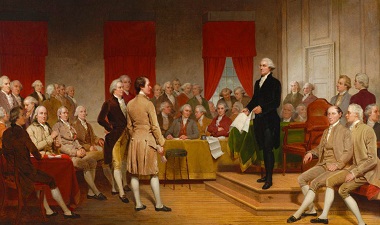
Getting Started
This module includes two Unboxing the Constitution videos (6 mins each), two Inside the Constitution videos (6 and 7 mins), student activities, and a learning project. Download the Teachers Guide and the Student Content Guide for more details on content and implementation. Course materials are provided in Google documents, Word documents, as well as printable PDFs.
A preview of the module can be accessed below.
Topics covered include:
- The Amendment Process
- Times of Constitutional Change
- Amendments to the Constitution
- Amendment Impacts

Vocabulary
At the beginning of each module, students are presented with vocabulary words and definitions.
Concept Words
Concept words are conceptually related to the big ideas in what they’re learning. These connect directly to the core concepts or themes of the lesson or unit and help students grasp the main ideas and how everything fits together.
- Abridged: Cut short or limited
- Affirmation: A promise to tell the truth (like an oath, but without religious wording)
- Apportionment: the way something (like seats in Congress) is divided among states
- Cruel and unusual punishment: harsh punishments that aren’t normal
- Double jeopardy: being tried twice for the same crime (which is not allowed)
- Grand jury: a group that decides if there’s enough evidence for a trial
- Jurisdiction: the area or power a court or authority has to make legal decisions
- Probable cause: a good reason to believe something illegal has happened
- Prohibition: a rule or law that says something is not allowed
- Succession: the order in which people take over a job or role (like the presidency)
Speed Bump Words
Speed bump words are words that aren’t central to the concept being taught, but if students don’t understand them, they may struggle to comprehend the text or lesson. These words can help shape students' overall understanding of the topic.
- Ascertain: to find out or figure out something for sure
- Bail: money paid to get out of jail while waiting for trial
- Compensation: payment for work or to make up for something lost
- Compulsory: required; something you must do
- Constituting: making up or forming something
- Controversy: a serious disagreement or argument
- Delegated: Given to someone else to take care of (like powers given to the government)
- Disparage: to put something down or say it doesn’t matter
- Indictment: a formal charge saying someone probably committed a crime
- Infringed: taken away or limited (like a right or freedom)
- Inhabitant: a person who lives in a certain place
- Intervening: coming in between two things, events, or times
- Income tax: money people pay the government based on how much they earn
- Just compensation: fair payment for something taken (like land for public use)
- Prescribed: set or ordered by a rule or law
- Prosecuted: taken to court and tried for a crime
- Repeal: to cancel a law

Topic 1: Amending the Constitution
It is not easy to amend the Constitution, and this was deliberate. The founding generation knew it was important for changes to be possible, but they wanted a process that would require broad support for changes to the Constitution.
15.1: Activate Prior Knowledge
Students will brainstorm constitutional amendments.
Unboxing the Constitution - Video One
In this Unboxing the Constitution video, Lucy explains the amendment process outlined in Article V and talks about some unique amendments to the Constitution.
15.2: Article V Explained
Students will explore Article V and outline the two pathways to amend the Constitution.
15.3: Closing Activity
Students will check in on the Key Question(s).

Topic 2: The 27 Amendments
The English word amend comes from a Latin word meaning “to free from error” or “to correct.” This is one way to think about the amendment process, as a method of adjusting the Constitution to make for “a more perfect union.” Throughout American history, “We the People” have amended our Constitution 27 times—often transforming it in important ways.
15.4: Times of Change
This Unboxing the Constitution video explores times of constitutional change throughout history.
Unboxing the Constitution - Video Two
Students should use these Inside the Constitution videos to deepen understanding of eras of constitutional change by taking notes and identifying themes.
Inside the Constitution Part I
Inside the Constitution Part II
15.5: Amendments to the Constitution
Students will explore the amendments that were ratified during key periods of American history– the Founding Era, Reconstruction Era, Progressive Era, and Modern Era.
15.6: Civic Connection: Amendments Matter
In this Civic Connection activity, students will dive even deeper into one amendment from the Constitution, thinking about its history and its impact today.
15.7: Reflect
To end this module, students should revisit the brainstorm activity and key questions to see how insights have grown throughout the lesson.

Learning Project: Pitch or Pass
In this project, students will explore the amendment process, first by researching an existing amendment, and then proposing a new one. They will then craft a persuasive "Shark Tank"-style pitch to convince a panel of "investors" (classmates or the teacher) that their amendment is necessary and should be ratified.












